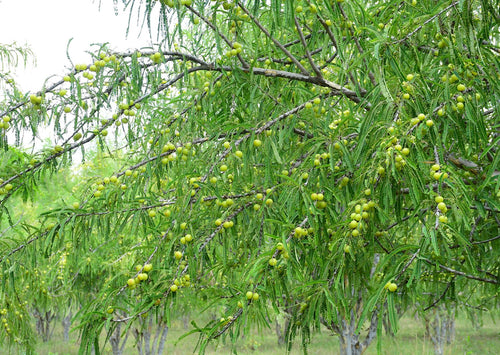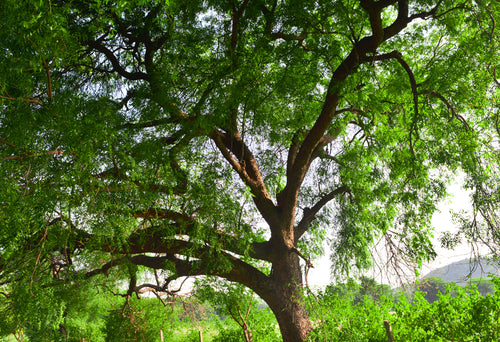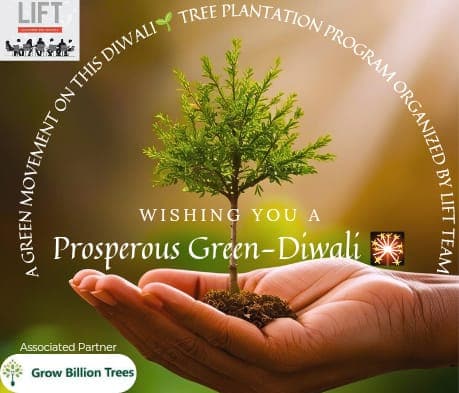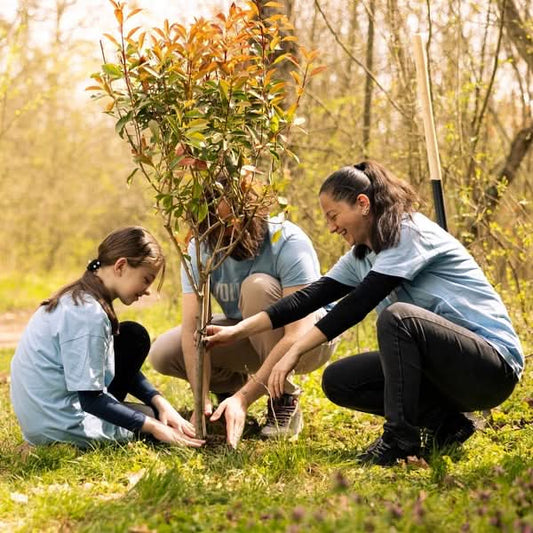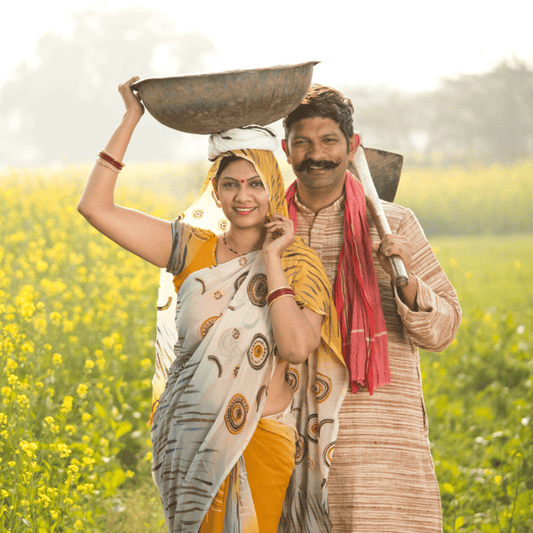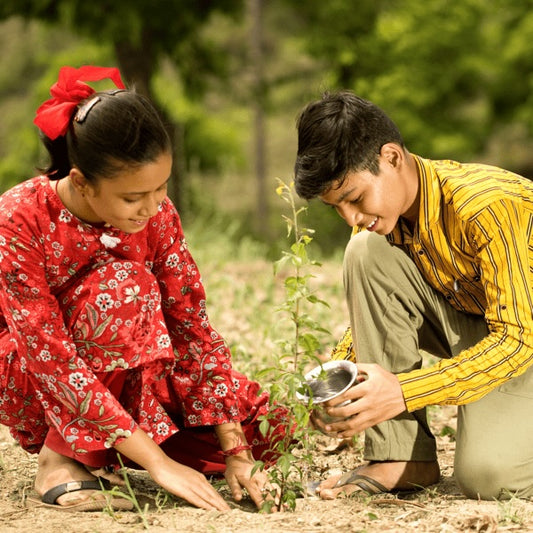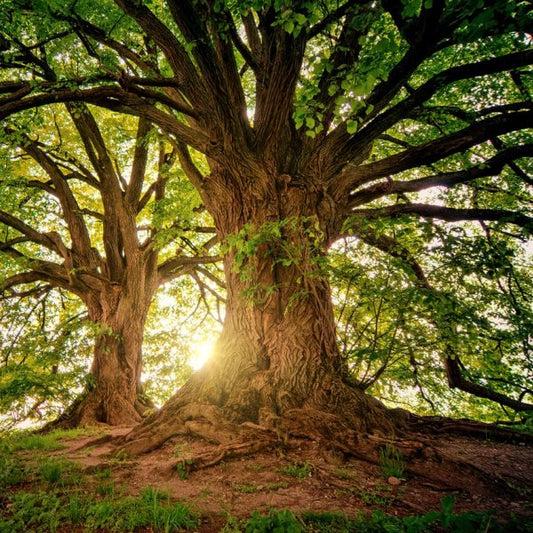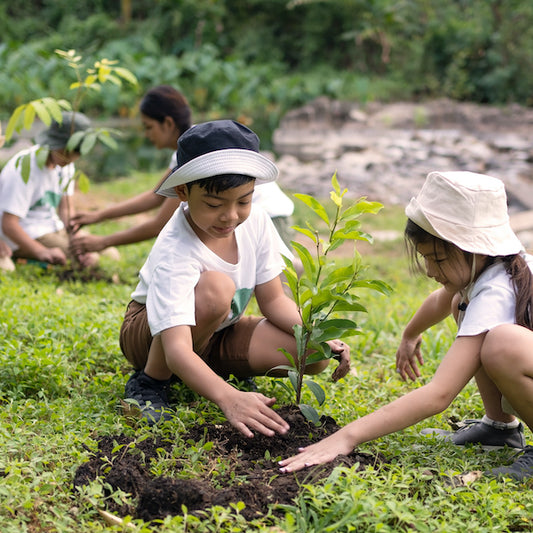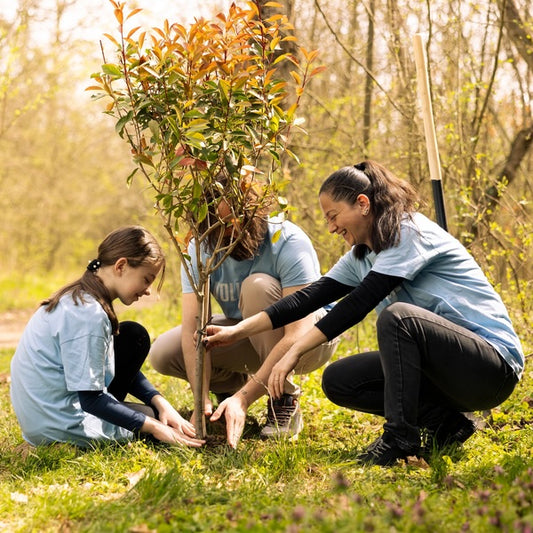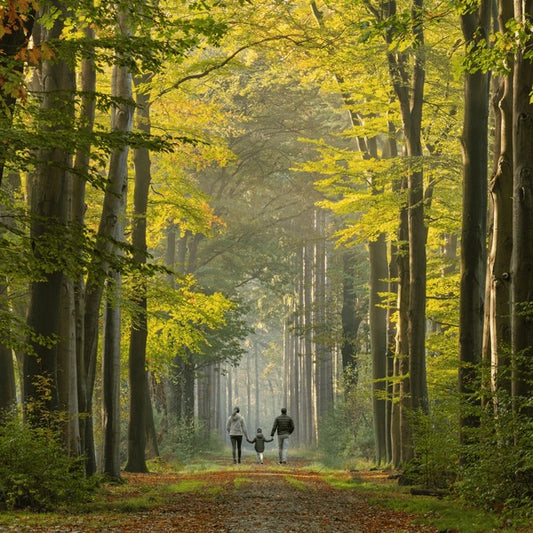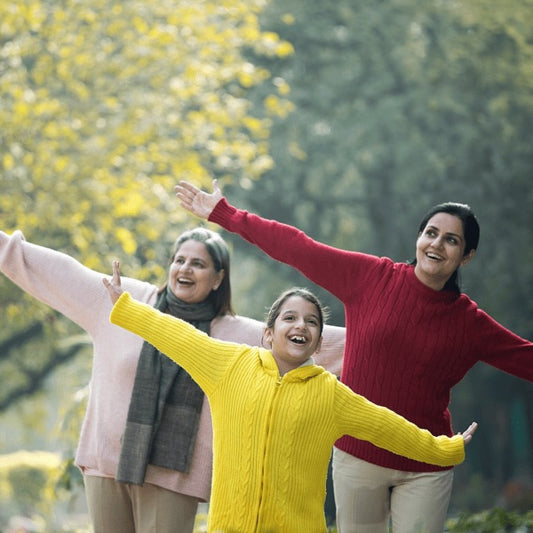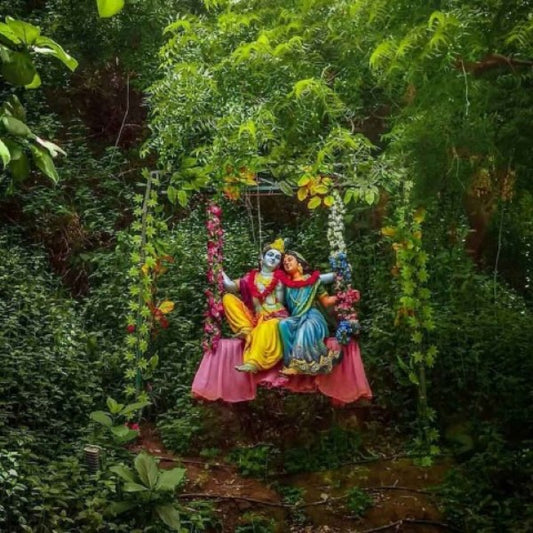Group Landmark’s ROAR (Reduce to Zero, Add Responsibly) Initiative: Ac
Group Landmark, a leader in the Indian automobile dealership sector, has taken a decisive step towards environmental sustainability through its ROAR ( Read more
Project Update 2
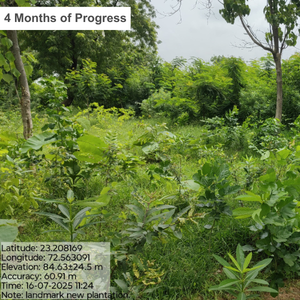
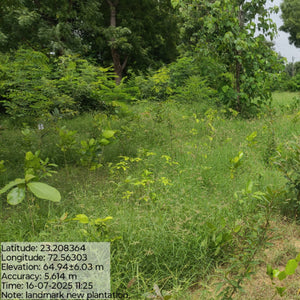
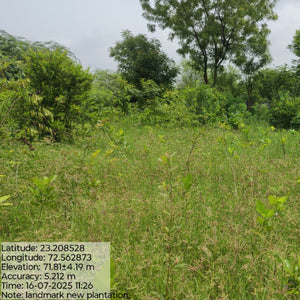
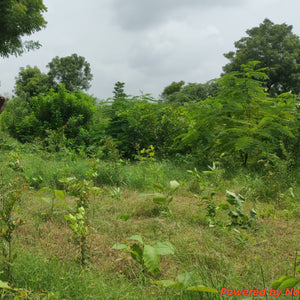
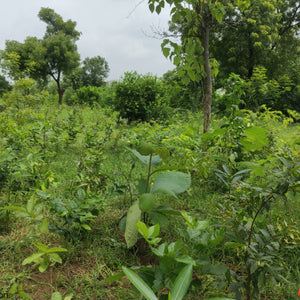

Project Update 1
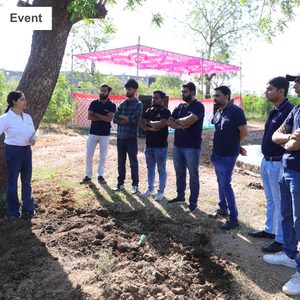
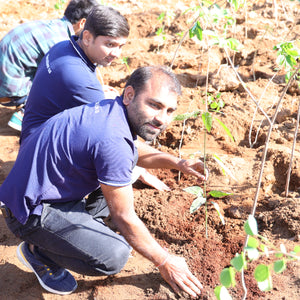
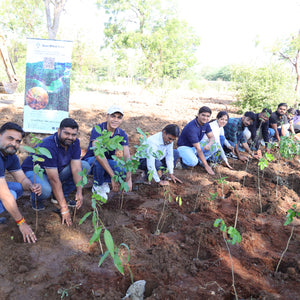
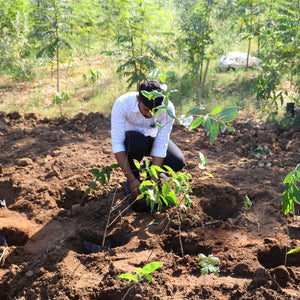
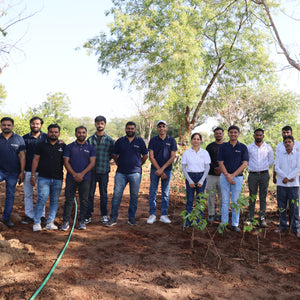
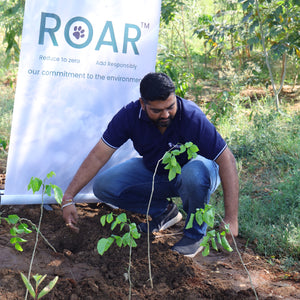
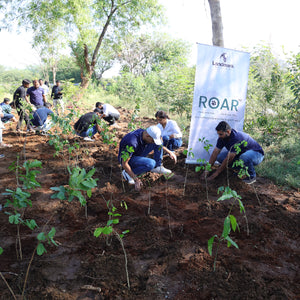
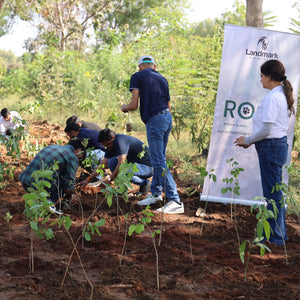
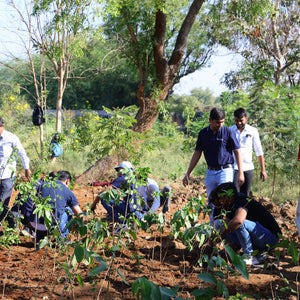
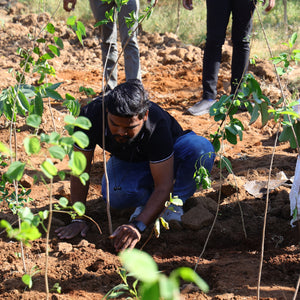
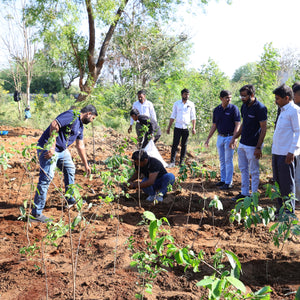
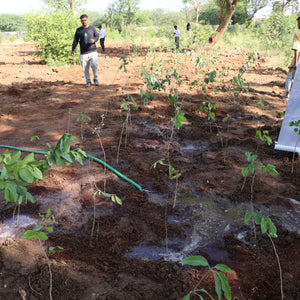
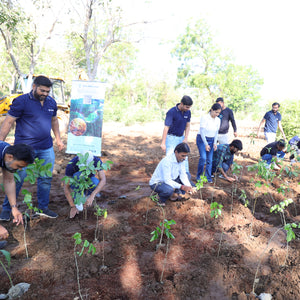
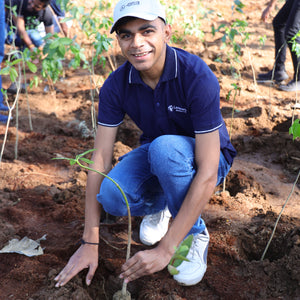
Digital Forest
Forest with 5,014 Trees planned
Want to plant your tree now?
Plant a Tree @ 299Group Landmark’s ROAR (Reduce to Zero, Add Responsibly) Initiative: Accelerating Urban Greening with Miyawaki Forests
Group Landmark, a leader in the Indian automobile dealership sector, has taken a decisive step towards environmental sustainability through its ROAR (Reduce to Zero, Add Responsibly) Initiative. As part of its CSR commitment, the company partnered with Grow Billion Trees to create a Miyawaki forest in Ahmedabad, reinforcing its dedication to urban greening.
Unlike conventional plantations, Miyawaki forests grow ten times faster and are thirty times denser, creating a thriving ecosystem that enhances biodiversity and improves air quality. This initiative, launched on Earth Day, marks a significant leap toward sustainable urban development. Group Landmark is committed to nurturing this green space for the next three years, ensuring it evolves into a self-sustaining forest that benefits both the environment and the community. Through this endeavor, Group Landmark continues to drive impactful change, proving that responsible business practices and environmental stewardship go hand in hand.
Project Planning & Execution
No of Trees: 5014
Plantation Location: Sadvichar Parivar Viklang Punervas Kendra, Shertha, Gujarat 382422
Plantation Duration: 19th March 2025 to 24th March 2025
Name of Species: Ardusa, Badam, Baheda, Jambu, Kadamb, Amla, Amli, Arjun, Australian Acacia, Baka Neem, Bili, Bottle Brush, Garmala, Goras Amli, Gulmohar, Jamfal, Kacchnar, Kanji, Kashid, Kathal, Kesuda, Lagerstroemia, Mahuda, Neem, Pangara, Papdi, Peltoform, Pilkhan, Putranjiva, Saptaparni, Saragva, Saru, Silver Oak, Sitafal, Umro, Ardusi, Dadam, Karen, Limbu, Meetha Neem, Parijat, Setur, and Tecoma Stans, Chandani
Species Selection & Its Benefits:
The carefully selected tree species for the Group Landmark Miyawaki Forest project at Shertha, Gujarat, including Muchkand, Khaya, Gulbhendi, Karanj, Arjun, Palas, and Kadamb, have been chosen for their ecological and social benefits. These species contribute significantly to enhancing biodiversity by providing habitats for wildlife and pollinators, improving soil fertility, and aiding in groundwater recharge. Trees like Shirish and Putranjiva create cooling microclimates, helping mitigate the urban heat island effect, while species such as Jamun and Ber contribute to local food resources.
In addition to their ecological value, these species offer considerable social and economic benefits. Trees like Jackfruit, Guava, and Lemon provide edible fruits, supporting local communities and fostering sustainable livelihoods. Others, such as Arjun and Dhawada, are known for their medicinal properties. By improving air quality, offering shade, and creating green spaces, these trees enhance the quality of life for residents and visitors.
By prioritizing native species like Neem, Palas, and Bija, the project ensures a resilient and sustainable miyawaki forest that effectively addresses environmental challenges while meeting community needs.
| Total Trees Planted: 5014 | |
| Total Species Planted: 44 | |
| Layer 1 | 5 species |
| Layer 2 | 30 species |
| Layer 3 | 8 species |
| Layer 4 | 1 species |
| Layer 1 ( Canopy layer ) | |||
| Trees name | Botanical name | Benefits | Number of plants |
| Ardusa (Ailanthus trifoliata) | Justicia adhatoda | Fast-growing, tolerant of various soil conditions, nitrogen-fixing | 150 |
| Badam (Almond) | Prunus dulcis | Edible nuts, ornamental value, attracts pollinators | 50 |
| Baheda (Terminalia bellirica) | Terminalia bellirica | Medicinal properties used in Ayurvedic medicine | 50 |
| Jambu (Eugenia jambos) | Syzygium cumini | Edible fruits, ornamental value | 150 |
| Kadamb (Anthocephalus cadamba) | Neolamarckia cadamba | Sacred tree in Hinduism, medicinal properties | 150 |
| Layer 2 ( Tree Layer ) | |||
| Trees name | Botanical name | Benefits | Number of plants |
| Amla (Indian Gooseberry) | Phyllanthus emblica | Rich in vitamin C, boosts immunity, improves digestion, has medicinal properties | 150 |
| Amli (Tamarind) | Tamarindus indica | Provides shade, edible fruits, medicinal properties | 150 |
| Arjun (Terminalia arjuna) | Terminalia arjuna | Heart-protective properties, drought-tolerant | 120 |
| Australian Acacia (Acacia mearnsii) | Acacia mearnsii | Fast-growing, provides shade, nitrogen-fixing | 150 |
| Baka Neem (Azadirachta indica) | Azadirachta Indica | Medicinal properties, pest repellent | 150 |
| Bili (Aegle marmelos) | Aegle marmelos | Edible fruits, medicinal properties | 50 |
| Bottle brush (Callistemon citrinus) | Callistemon | Ornamental flowers, attracts birds | 50 |
| Garmala (Peganum harmala) | Cassia fistula | Medicinal properties, used in traditional medicine | 150 |
| Goras amli (Garcinia cambogia) | Pithecellobium dulce | Edible fruits, weight loss properties | 50 |
| Gulmohar (Delonix regia) | Delonix regia | Ornamental flowers, shade | 150 |
| Jamfal (Syzygium cumini) | Psidium guajava | Edible fruits, medicinal properties | 50 |
| Kacchnar (Bauhinia variegata) | Bauhinia variegata | Ornamental flowers, medicinal properties | 250 |
| Kanji | Pterocarpus marsupium | Medicinal properties, used in Ayurvedic medicine | 250 |
| Kashid (Sterculia urens) | Peltophorum pterocarpum | Edible gum, medicinal properties | 250 |
| Kathal (Jackfruit) | Artocarpus heterophyllus | Largest edible fruit, provides shade | 50 |
| Kesuda (Butea monosperma) | Butea monosperma | Ornamental flowers, medicinal properties | 50 |
| Lagerstroemia (Lagerstroemia indica) | Lagerstroemia indica, | Ornamental flowers, attracts pollinators | 50 |
| Mahuda (Madhuca longifolia) | Madhuca longifolia | Edible flowers and seeds, medicinal properties | 50 |
| Neem (Azadirachta indica) | Azadirachta indica | Medicinal properties, pest repellent | 250 |
| Pangara (Pongamia pinnata) | Erythrina variegata | Medicinal properties, used in Ayurvedic medicine | 30 |
| Papdi (Sterculia urens) | Holoptelea integrifolia | Edible gum, medicinal properties | 100 |
| Peltoform (Peltophorum pterocarpum) | Peltophorum pterocarpum | Ornamental flowers, shade | 200 |
| Pilkhan (Ficus religiosa) | Ficus virens | Sacred tree in Buddhism, provides shade | 50 |
| Putranjiva (Putranjiva roxburghii) | Putranjiva roxburghii | Edible seeds, medicinal properties | 100 |
| Saptaparni (Tridax procumbens) | Alstonia scholaris | Medicinal properties, used in traditional medicine | 150 |
| Saragva (Clematis gouriana) | Moringa oleifera | Ornamental flowers, medicinal properties | 150 |
| Saru (Cupressus torulosa) | Casuarina Equisetifolia | Ornamental tree, windbreak | 50 |
| Silver oak (Grevillea robusta) | Grevillea robusta | Fast-growing, provides shade, drought-tolerant | 50 |
| Sitafal (Annona squamosa) | Annona squamosa | Edible fruits, medicinal properties | 200 |
| Umro (Ficus racemosa) | Ficus racemosa | Edible fruits, provides shade | 100 |
| Layer 3 ( Shrub Layer) | |||
| Trees name | Botanical name | Benefits | Number of plants |
| Ardusi (Morinda citrifolia) | Justicia adhatoda | Edible fruits, medicinal properties | 150 |
| Dadam (Cordia myxa) | Punica granatum | Edible fruits, medicinal properties | 50 |
| Karen (Crataeva religiosa) | Nerium Oleander | Medicinal properties, used in traditional medicine | 100 |
| Limbu (Citrus limon) | Citrus limon | Edible fruits, medicinal properties | 50 |
| Meetha Neem (Azadirachta indica) | Murraya koenigii | Medicinal properties, less bitter than neem | 50 |
| Parijat (Jasminum sambac) | Nyctanthes arbor-tristis | Fragrant flowers, medicinal properties | 150 |
| Setur (Ziziphus jujuba) | Morus Nigra | Edible fruits, medicinal properties | 150 |
| Tecoma Stans (Tecoma stans) | Tecoma stans | Ornamental flowers, medicinal properties | 100 |
| Layer 4 ( Ground Layer ) | |||
| Trees name | Botanical name | Benefits | Number of plants |
| Chandani (Tabernaemontana divaricata) | Tabernaemontana divaricata | Fragrant flowers, medicinal properties | 50 |
Beneficiaries Details
-
Target Population: Employees, stakeholders, and local community members of Shertha, Gujarat.
-
Age Group: Inclusive of all age groups, ensuring broad community participation.
-
Gender: Inclusive of all genders.
- Social & Economic Status: Open to all social and economic backgrounds, emphasizing community involvement.
Planting Methodology and Its Advantages
Group Landmark, under its ROAR (Reduce to Zero, Add Responsibly) Initiative, has embraced the Miyawaki forest concept to drive urban sustainability and ecological restoration. This innovative afforestation method enables forests to grow ten times faster and thirty times denser than traditional plantations, creating a thriving, self-sustaining ecosystem. In collaboration with Grow Billion Trees, Group Landmark transformed a space in Ahmedabad into a Miyawaki forest, reinforcing its commitment to environmental responsibility. This initiative, launched as part of its CSR efforts, not only enhances biodiversity but also improves air quality, reduces carbon footprints, and fosters a greener future. With a dedicated three-year maintenance plan, Group Landmark ensures the long-term success of this miyawaki forest, making a lasting impact on both the environment and the community.
Four-Step Process of Planting a Miyawaki Forest:
1. Preparation and Analysis
- Site Analysis: Begin with a thorough analysis of the site, considering factors like soil type, water availability, and sunlight exposure. This analysis guides the selection of native plant species best suited for the location.
- Soil Preparation: Clear the area of weeds and debris. Loosen the soil by tilling and amend it with organic compost to enhance fertility and moisture retention.
2. Plant Selection and Planting
- Plant Selection: Choose native plant species that are fast-growing, drought-resistant, and indigenous to the region. Diversity is crucial to mimic natural forests and promote ecological balance.
- Planting Technique: Dig pits or trenches for planting saplings, ensuring each has enough space to grow. Plant at a high density, typically 3 to 5 times denser than traditional forests.
3. Care and Maintenance
- Watering: Initially, saplings need regular watering to establish their roots. Once established, they require less frequent watering, but regular monitoring remains essential.
4. Monitoring and Growth
- Regular Maintenance: Perform regular weeding, pruning, and pest control during the initial years. Miyawaki forests become self-sustainable as they mature, but still require occasional maintenance.
- Monitoring: Keep track of the forest's growth and health, monitoring for signs of stress, disease, or pest infestations, and taking timely action when needed.
Four Layers of a Miyawaki Forest
The Miyawaki method emphasizes creating a multi-layered forest that mimics natural forests to achieve rapid growth and high biodiversity. Here are the four layers typically found in a Miyawaki forest:
- Canopy Layer: This topmost layer consists of tall trees that provide the canopy. These trees are usually fast-growing species that can reach heights of 15 to 30 meters or more. They offer shade and protection to the layers below.
- Tree Layer: Beneath the Canopy layer is the tree layer, consisting of smaller trees and larger shrubs. These plants help fill in the gaps between the taller trees, contributing to the dense foliage that characterizes a mature forest.
- Shrub Layer: Below the canopy, the shrub layer includes smaller shrubs and bushes that provide additional structure and diversity to the forest. These plants play a vital role in attracting pollinators and providing habitat for various wildlife.
- Ground Layer: The lowest layer is the ground layer, comprising ground covers, ferns, and herbaceous plants. These plants help to retain moisture, suppress weeds, and protect the soil. They also contribute to the overall biodiversity by providing habitat for insects and microorganisms.


Each layer in a Miyawaki forest serves a unique purpose and contributes to the forest's resilience, biodiversity, and ecological functionality.
Advantages of the Miyawaki Technique
-
Faster Growth: Vegetation grows up to 10 times faster than with conventional methods due to high-density planting, soil conditioning, and native species selection. It reaches maturity in 20-30 years instead of over a century, making it highly effective for ecological restoration.
-
Biodiversity Enhancement: The technique encourages a diverse mix of native species, supporting wildlife such as birds, insects, and small mammals, contributing to habitat restoration and ecosystem resilience.
-
Sustainability: After the initial 3 years, these green spaces become self-sustaining, requiring minimal intervention. Natural mulch helps retain moisture and suppresses weed growth, making maintenance cost-effective.
-
Soil Health Improvement: Organic matter decomposition enhances soil fertility while root systems aerate the ground, improving water retention and preventing erosion, especially in degraded or sloped areas.
-
Microclimate Regulation: The dense vegetation reduces heat absorption, increases moisture release, and combats the urban heat island effect, improving air quality and energy efficiency in nearby structures.
-
Space Efficiency: This method allows for high-density planting in small areas, making it ideal for urban spaces, schools, and community parks, even on degraded land.
-
Ecosystem Restoration: By using native species, these forests seamlessly reintegrate with local ecosystems, supporting pollinators and maintaining ecological balance.
- Low Water Consumption: Once established, the dense planting and bio mulch help retain moisture, reducing the need for frequent watering, making it a sustainable solution even in water-scarce regions.
Activities During Tree Plantation
Group Landmark proudly unveiled its ROAR (Reduce to Zero, Add Responsibly) initiative as part of its CSR commitment to environmental sustainability. Under this banner, the company launched a meaningful tree plantation drive using the Miyawaki method, a step that intertwines ecological restoration with active community involvement.
The initiative was more than a symbolic gesture; it was a well-planned effort with site preparation, careful native species selection, and a strong focus on employee participation. Group Landmark employees came together with great enthusiasm, joined by Ms. Nidhi Singh, Co-Founder and CEO of Grow Billion Trees, to bring this green vision to life.
This Miyawaki forest represents a long-term investment in biodiversity and urban greening. But beyond that, it reflects a shared belief: that by planting trees, we also plant hope. Through ROAR, Group Landmark is not only reducing its footprint but actively adding value responsibly to create a sustainable tomorrow.
Conclusion Elements
Impact
Direct Impact
| Parameters | Values | References |
| No. of Trees Planted | 5,014 | |
| Green Cover (Acres) | 0.312 | |
| Carbon Sequestration Potential (KG) | 5 |
Small to medium-sized trees can sequester around 10–48 kilograms (22–106 pounds) of CO₂ annually. https://growbilliontrees.com/blogs/knowledge/how-much-co2-can-one-tree-absorb |
| Carbon Sequestration by 5014 mature trees ( Tons/year) | 25 Tons | No. of Trees x Carbon Sequestration by 1 mature trees per year |
| Carbon Credit Equivalent | 25 | One carbon credit is equivalent to one tonne of carbon dioxide or the equivalent amount of another greenhouse gas. |
| Carbon Footprint of an avg Indian Citizen (Tons/Year) | 1.8 | https://www.iea.org/countries/india/emissions |
| Offsets Annual Carbon Footprint of (Adults) | 14 | Carbon offset by 5014 mature trees per year / Carbon Footprint of an avg Indian Citizen per year |
*This impact analysis is forward-looking (A Miyawaki - Forest project matures in 2-3 years)
Indirect Impact
Community Impact
-
Environmental Awareness: Involving employees and local communities in the plantation drive fosters greater awareness about environmental conservation and encourages sustainable practices in daily life.
-
Employee Morale & Engagement: The initiative instilled a sense of pride, ownership, and teamwork among employees, strengthening their connection to the company’s sustainability goals and fostering a culture of environmental responsibility.
-
Inspiration for Change: By showcasing the rapid and dense growth of Miyawaki forests, this project has inspired organizations, institutions, and local communities to adopt this innovative afforestation method, encouraging widespread urban greening and ecological restoration efforts.
-
Cultural Shift: The initiative cultivated a long-term mindset of sustainability, encouraging participants to become advocates for green practices in both their personal and professional lives.
-
Enhanced Community Collaboration: Strengthened ties between corporate stakeholders, local authorities, and environmental groups, creating a collaborative approach to sustainability.
Environmental Impact
-
Biodiversity Conservation - By introducing native plant species, the project supports local wildlife, including birds, insects, and pollinators, fostering a healthier and more diverse ecosystem.
-
Carbon Sequestration – The planted trees act as natural carbon sinks, absorbing carbon dioxide and helping mitigate climate change by reducing greenhouse gas emissions.
-
Air Purification – Trees filter pollutants such as carbon monoxide, nitrogen oxides, and particulate matter, improving air quality and promoting a healthier environment.
-
Microclimate Regulation –The plantation reduces the urban heat island effect, cooling the surrounding area and helping to regulate temperature, making urban environments more comfortable.
-
Water Conservation - The bio mulch created by the plantation helps retain soil moisture, reducing the need for frequent watering and promoting efficient water use in the ecosystem.
-
Soil Health Improvement – The plantation enriches soil fertility by adding organic matter, improving soil structure, and supporting surrounding vegetation.
-
Erosion Prevention – Tree roots stabilize the soil, preventing erosion caused by wind and water, which helps protect infrastructure, roads, and green spaces.
- Noise Reduction – Green spaces serve as natural sound barriers, dampening noise pollution and contributing to a quieter, more peaceful environment.
Achievements
SDG Goals Achieved Through Miyawaki Plantation
-
SDG 3: Good Health and Well-Being – The establishment of green spaces through this project promotes good health and well-being for the community. These green areas improve air quality, reduce stress, and contribute to the overall better mental and physical health of the community.
-
SDG 6: Clean Water and Sanitation – Through Group Landmark's tree plantation project, significant strides have been made in water conservation. The planted trees enhance soil structure, increase water retention, and reduce surface runoff, preventing soil erosion and promoting groundwater recharge. This ensures sustainable water resources for the surrounding community, improving local access to clean water.
-
SDG 7: Affordable and Clean Energy – As part of its contribution to affordable and clean energy, Group Landmark's plantation aids in cooling urban spaces, thus reducing the demand for air conditioning and lowering energy consumption. By mitigating heat and improving local microclimates, the initiative supports energy efficiency and reduces reliance on energy-intensive cooling systems.
-
SDG 8: Decent Work and Economic Growth – The plantation project by Group Landmark also provides economic opportunities by creating jobs and encouraging local engagement in the process of tree planting and maintenance. Employees and local workers gain skills, fostering economic development in the region while contributing to long-term sustainability.
-
SDG 9: Industry, Innovation, and Infrastructure – Group Landmark’s plantation also aligns with SDG 9, focusing on fostering innovation in sustainable practices. By utilizing advanced techniques like the Miyawaki method, the company contributes to the development of eco-friendly infrastructure, showcasing a sustainable approach to land use and environmental conservation. This innovation in planting methods helps restore degraded areas, enhancing green infrastructure.
-
SDG 11: Sustainable Cities and Communities – By planting in urban areas, it enhances green cover, reduces pollution, and helps combat the urban heat island effect, making cities more resilient and livable. This initiative contributes to the development of sustainable communities, providing residents with cleaner air, recreational spaces, and an improved quality of life.
-
SDG 12: Responsible Consumption and Production – Under the ROAR (Reduce to Zero, Add Responsibly) Initiative, Group Landmark is committed to sustainable resource usage. The plantation follows eco-friendly practices, ensuring minimal waste and no artificial fertilizers or pesticides. By fostering a circular and responsible approach to green initiatives, the company sets an example of sustainable corporate responsibility.
-
SDG 13: Climate Action – Group Landmark's tree plantation initiative contributes significantly to climate action by helping mitigate climate change through carbon sequestration. The newly planted greenery absorbs carbon dioxide, reducing the carbon footprint of the area. Additionally, the project combats the urban heat island effect, lowering temperatures and improving the local climate resilience.
-
SDG 15: Life on Land – The plantation directly supports biodiversity conservation by introducing a variety of native plant species, which provide vital habitats for local wildlife, including pollinators and small animals. This restoration of ecosystems helps prevent biodiversity loss and strengthens the surrounding natural environment, fostering a balanced and thriving ecosystem.
-
SDG 17: Partnerships for the Goals – Group Landmark’s plantation initiative promotes collaboration and partnerships with various stakeholders, including employees and Grow Billion Trees. By working together towards common goals, the project strengthens partnerships that amplify the positive impact on environmental sustainability and community well-being. The collective effort of all partners helps achieve shared goals and builds a network for future sustainable initiatives.
ESG Achieved through Miyawaki Plantation
-
Environmental Impact: Group Landmark's Miyawaki plantation has a significant positive effect on the environment. By planting native species densely, it enhances biodiversity, provides vital habitats for wildlife, and supports the survival of pollinators and other beneficial organisms. Additionally, the dense green cover contributes to carbon sequestration, helping to mitigate climate change by absorbing carbon dioxide from the atmosphere. The plantation also promotes soil and water conservation, improving soil fertility, preventing erosion, and increasing water retention. These benefits ensure the health of the land and contribute to sustainable water management. Furthermore, the cooling effect generated by the dense vegetation combats the urban heat island effect, reducing temperature fluctuations and contributing to a more stable microclimate in urban spaces.
-
Social Impact: The Miyawaki plantation method encourages active community engagement by involving employees and other stakeholders in planting and maintaining green spaces. This participatory approach fosters a sense of ownership and pride, which leads to stronger community bonds and a collective responsibility for environmental sustainability. Moreover, the greenery helps to improve health and well-being by purifying the air, reducing pollutants, and creating more pleasant and healthier environments. These green spaces provide areas for relaxation and recreation, contributing to improved mental and physical health. The project also serves as an educational tool, raising awareness and informing the public about the importance of environmental conservation, sustainability practices, and the benefits of native vegetation. Furthermore, the project supports local livelihoods by generating employment opportunities in tree planting, maintenance, and environmental stewardship.
- Governance Impact: The Miyawaki plantation method also strengthens governance by promoting transparency and accountability in environmental practices. By following a structured, well-documented approach, the project ensures that all activities are carried out ethically and in accordance with environmental guidelines. The initiative supports compliance with local and global environmental regulations, ensuring that the project aligns with established sustainability standards. Additionally, the long-term sustainability of the plantation, requiring minimal intervention after the initial years, reflects the organization's commitment to responsible environmental stewardship. By focusing on sustainable practices, the project highlights the company’s dedication to governance and reinforces its role as a responsible corporate entity in contributing to environmental protection and social well-being.
Building Communities
One of the most profound impacts of Group Landmark's Miyawaki plantation initiative has been the spirit of unity and collaboration it fostered. By actively involving employees, local communities, and volunteers, the project became more than just a tree plantation drive; it evolved into a shared mission to create resilient and sustainable green spaces. This collective effort has strengthened environmental consciousness and encouraged long-term stewardship of natural resources.
-
Empowering Communities: This initiative actively engages employees and stakeholders in the planting and maintenance processes. This involvement fosters a sense of ownership over the green spaces, empowering individuals to take responsibility for their environment. As participants contribute to the growth of their community’s green cover, they become more connected to their surroundings, building pride and a shared commitment to sustainability.
-
Fostering Meaningful Partnerships: The initiative brought together key stakeholders, including Group Landmark, Grow Billion Trees, and local communities, demonstrating the power of collaboration in achieving lasting environmental and social change. These partnerships strengthened the collective commitment to sustainability, ensuring that afforestation efforts continue to thrive in the long run.
-
Inspiring a Ripple Effect: As the benefits of the afforestation project became evident, improved air quality, enhanced biodiversity, and increased community engagement, its impact extended beyond the immediate planting site. Local communities and organizations have been inspired to replicate similar initiatives, amplifying the project's reach and reinforcing the importance of urban greening.
This initiative exemplifies that true environmental sustainability is not just about planting trees, it’s about nurturing awareness, fostering collaboration, and creating a shared vision for a healthier, greener, and more sustainable future.
Commitment by Grow Billion Trees
-
Ensuring Tree Survivability: GBT prioritizes native species, continuous monitoring, and soil health improvement using organic fertilizers. These efforts ensure sustainable growth and benefit communities.
-
Transparency & Accountability: GBT provides detailed reports on tree growth, survival rates, and carbon benefits, using geo-fencing and regular updates to maintain transparency and effectiveness.
-
Sustainable Plantation Efforts: GBT implements projects that balance environmental, social, and economic goals, addressing issues like urban heat islands and degraded farmlands. These efforts promote ecological balance, livelihoods, and long-term climate resilience.
-
Enhancing Ecosystem Health: By selecting native species and creating diverse habitats, GBT enhances biodiversity and ecosystem resilience, ensuring long-term ecological health and supporting wildlife.
-
Long-Term Impact: GBT’s initiatives tackle environmental challenges, foster climate resilience, and promote sustainable development while reducing carbon footprints.
Acknowledgment
We at Grow Billion Trees extend our deepest gratitude to all those who have contributed to the success of the Miyawaki Forest project in Shertha, Ahmedabad (Gujarat). This initiative, which has transformed a once barren space into a thriving green sanctuary, would not have been possible without the support and collaboration of dedicated individuals and organizations.
To Group Landmark: We sincerely thank you for your unwavering commitment to environmental sustainability. Your vision for creating greener urban spaces and a more sustainable future has been the cornerstone of this project. Together, we have not only planted trees but have created a vibrant, living testament to the power of collective action in fostering a healthier planet.
To the Local Community of Shertha, Ahmedabad (Gujarat): Your enthusiasm, dedication, and hard work have been the driving force behind the success of this project. By embracing the creation of this urban forest, you have contributed to enhancing the quality of life in your neighborhood and improving the local environment. Your collective efforts have turned this vision into a reality, and we are deeply grateful for your active involvement and support.
To Our Partners and Volunteers: Your expertise, tireless commitment, and passion for creating sustainable, green spaces have been invaluable to the success of this initiative. From planning and planting to maintenance, your dedication has helped bring life to this urban forest. We are deeply thankful for your contribution to making this project a thriving success.
Together, we have made significant strides in improving air quality, promoting biodiversity, and enhancing the well-being of the local community. The Miyawaki Forest in Shertha stands as a symbol of our shared commitment to environmental stewardship and sustainability. This is only the beginning, and we look forward to continuing our partnership to create more green spaces and sustainable urban environments for future generations.
Thank you for your support and dedication.
Closing Remarks
We are proud to have partnered with Grow Billion Trees under Group Landmark’s CSR initiative, ROAR (Reduce to Zero, Add Responsibly), to establish a Miyawaki forest in Ahmedabad. This initiative reflects our unwavering commitment to urban greening and sustainability. By creating a high-density forest that grows ten times faster and is thirty times denser than conventional plantations, we are not only enhancing biodiversity but also restoring ecological balance in the heart of the city.
Launched on Earth Day, this project symbolizes a long-term vision for environmental restoration, backed by a three-year maintenance plan to ensure the forest evolves into a thriving, self-sustaining ecosystem. It stands as a living example of how corporate responsibility, when aligned with collective action, can make a lasting impact on our planet.
A heartfelt thank you to everyone who contributed to this journey. Together, we are sowing the seeds of a greener, healthier, and more sustainable future for generations to come.
Trees for Corporates
Trending
Most Popular
1. Group Landmark ROAR Initiative
Group Landmark’s ROAR (Reduce to Zero, Add Responsibly) Initiative is more than just a sustainability pledge—it’s a bold step toward rewilding urban spaces! Partnering with Grow Billion Trees, this initiative isn’t just about planting saplings but about nurturing a mini jungle in the city. Using the Miyawaki method, the project ensures these trees grow ten times faster and thirty times denser, turning grey spaces into lush green ecosystems. Celebrated on Earth Day, the initiative is a true testament to Group Landmark’s dedication to carbon neutrality, biodiversity, and urban cooling—all while making cities breathe a little easier.
2. Miyawaki Forest Benefits
What’s better than a tree? A whole jungle of them—growing at warp speed! The Miyawaki forest method ensures trees shoot up ten times faster and create a dense, oxygen-rich environment in record time. This translates to better air quality, thriving biodiversity, and cooler urban spaces—all in a compact area. Group Landmark’s initiative harnesses these benefits, proving that going green doesn’t have to be slow! With zero chemical fertilizers and a self-sustaining growth model, this isn’t just afforestation; it’s a green revolution on steroids!
3. Urban Greening with Miyawaki Forest
If cities had a wishlist, "more trees" would be at the top! Enter Miyawaki forests, the supercharged greenery solution turning concrete jungles into actual jungles. Group Landmark’s initiative in Ahmedabad is a perfect example of urban reforestation done right. These forests boost oxygen, absorb carbon, reduce noise pollution, and keep cities cooler. Think of it as nature’s air conditioner with a bonus wildlife sanctuary! In just a few years, what was once barren land will be a biodiversity hotspot—proof that concrete doesn’t have to be the final frontier.
4. Employee Engagement in Tree Plantation
Nothing says “teamwork” like getting your hands dirty for the planet! Group Landmark’s Miyawaki tree plantation wasn’t just an environmental effort—it was a bonding experience for employees. Armed with shovels and enthusiasm, they joined Grow Billion Trees volunteers to plant saplings and kickstart a green transformation. This hands-on engagement fosters team spirit, environmental awareness, and a sense of ownership over a lasting legacy. After all, who wouldn’t want to visit a thriving forest and say, “I helped plant that!”?
5. Sustainable Development Goals (SDGs) and Miyawaki Forests
Tree plantations aren’t just about greenery—they’re about meeting global sustainability goals! Group Landmark’s initiative checks off SDG 13 (Climate Action) by absorbing carbon, SDG 15 (Life on Land) by restoring biodiversity, and SDG 11 (Sustainable Cities) by improving air quality and reducing urban heat. With a three-year commitment to forest maintenance, this isn’t just a one-time CSR project—it’s a long-term investment in the planet!
6. Biodiversity Restoration through Miyawaki Method
If nature had a fast-forward button, it would be called the Miyawaki method. Unlike scattered plantations, this method mimics natural forests, ensuring multiple layers of vegetation grow together, creating a thriving habitat for birds, bees, and butterflies. Group Landmark’s initiative is more than just a green patch—it’s a sanctuary for urban wildlife. This project proves that even in a bustling city, nature can reclaim its space—faster, stronger, and wilder!
7. ESG Impact of Tree Plantation
Sustainability isn’t just a buzzword—it’s a corporate responsibility. Group Landmark’s Miyawaki forest initiative is a prime example of ESG (Environmental, Social, and Governance) in action. The project sequesters carbon (E), engages employees and communities (S), and reinforces sustainability in business strategy (G). With long-term maintenance and transparency, this initiative sets a benchmark for corporate sustainability—because businesses that care about the planet will always be ahead of the curve!
8. Earth Day Celebration with Tree Plantation
What’s a better way to celebrate Earth Day than by planting a forest? Group Landmark made April 22 extra special by launching its Miyawaki forest initiative, proving that climate action isn’t just about talking—it’s about doing. Employees, volunteers, and environmental enthusiasts came together to turn barren land into a thriving ecosystem. This wasn’t just a one-day event but the beginning of a long-term commitment to nature, ensuring the forest grows into a green lung for the city. Because what better gift to Mother Earth than more trees?
FAQ
What is Group Landmark’s tree plantation initiative?
Group Landmark’s tree plantation initiative is a part of its ROAR (Reduce to Zero, Add Responsibly) Initiative, aimed at promoting sustainability and urban greening. In collaboration with Grow Billion Trees, we have planted a Miyawaki forest in Ahmedabad. This fast-growing, dense forest helps restore biodiversity, improve air quality, and combat climate change. The initiative aligns with our commitment to environmental responsibility, ensuring a greener and healthier future.
How does the Miyawaki forest method work?
The Miyawaki method is a scientifically proven technique that enables trees to grow ten times faster and thirty times denser than conventional plantations. It involves planting native species close together, creating a self-sustaining forest that mimics natural ecosystems. The result is a lush, diverse green cover that enhances biodiversity, absorbs carbon, and improves urban air quality.
Why did Group Landmark choose the Miyawaki method?
We chose the Miyawaki method because it is one of the most effective reforestation techniques for urban areas. It ensures rapid growth, high survival rates, and maximum environmental impact in a small space. By adopting this method, we are contributing to urban biodiversity, carbon sequestration, and sustainable cities, making a lasting difference in the fight against climate change.
What is the impact of Group Landmark’s tree plantation initiative?
Our Miyawaki forest in Ahmedabad will contribute to cleaner air, lower temperatures, increased biodiversity, and improved soil health. Over time, this forest will become a self-sustaining ecosystem, absorbing carbon dioxide, reducing urban heat, and providing a habitat for birds and insects. It is a long-term commitment to environmental restoration and climate action.
How does Group Landmark ensure the trees survive?
Sustainability is at the core of our initiative. The trees are planted using the Miyawaki method, ensuring strong root systems and fast growth. We have also committed to a three-year maintenance plan to nurture the forest until it becomes self-sustaining. This includes regular monitoring, watering, and soil enrichment to ensure optimal growth.
Did Group Landmark employees participate in the plantation?
Yes! Our employees actively participated in planting the saplings along with volunteers from Grow Billion Trees. The site was prepared beforehand, and the plantation day involved placing saplings in pre-dug pits and watering them. This hands-on engagement helps foster environmental awareness, teamwork, and a deeper connection with nature.
How does Group Landmark’s initiative align with SDGs?
Our tree plantation initiative contributes to several United Nations Sustainable Development Goals (SDGs), including SDG 13 (Climate Action), SDG 15 (Life on Land), and SDG 11 (Sustainable Cities and Communities). By creating a dense, fast-growing forest, we are promoting urban sustainability, biodiversity conservation, and long-term environmental impact.
What are the advantages of a Miyawaki forest compared to traditional plantations?
Miyawaki forests grow ten times faster, are thirty times denser, and require minimal maintenance after the initial years. Unlike traditional plantations, which take decades to mature, Miyawaki forests establish within three years and become completely self-sufficient. They provide better carbon sequestration, improved air quality, and greater biodiversity in a much shorter time.
How does Group Landmark’s partnership with Grow Billion Trees support sustainability?
Our partnership with Grow Billion Trees ensures a scientifically backed, well-executed, and sustainable tree plantation initiative. Their expertise in afforestation, combined with our commitment to sustainability, allows us to create long-lasting green spaces that benefit both the environment and the community. Together, we are working towards a greener, healthier, and more sustainable future.
How can individuals contribute to tree plantation initiatives like this?
Anyone can contribute by planting trees, supporting afforestation programs, and spreading awareness about urban greening. Small actions, like choosing native plants, reducing carbon footprints, and volunteering for tree plantations, make a significant impact. By joining hands with organizations like Grow Billion Trees or supporting corporate sustainability initiatives like ours, individuals can actively participate in building a greener future.
- Choosing a selection results in a full page refresh.
- Opens in a new window.


